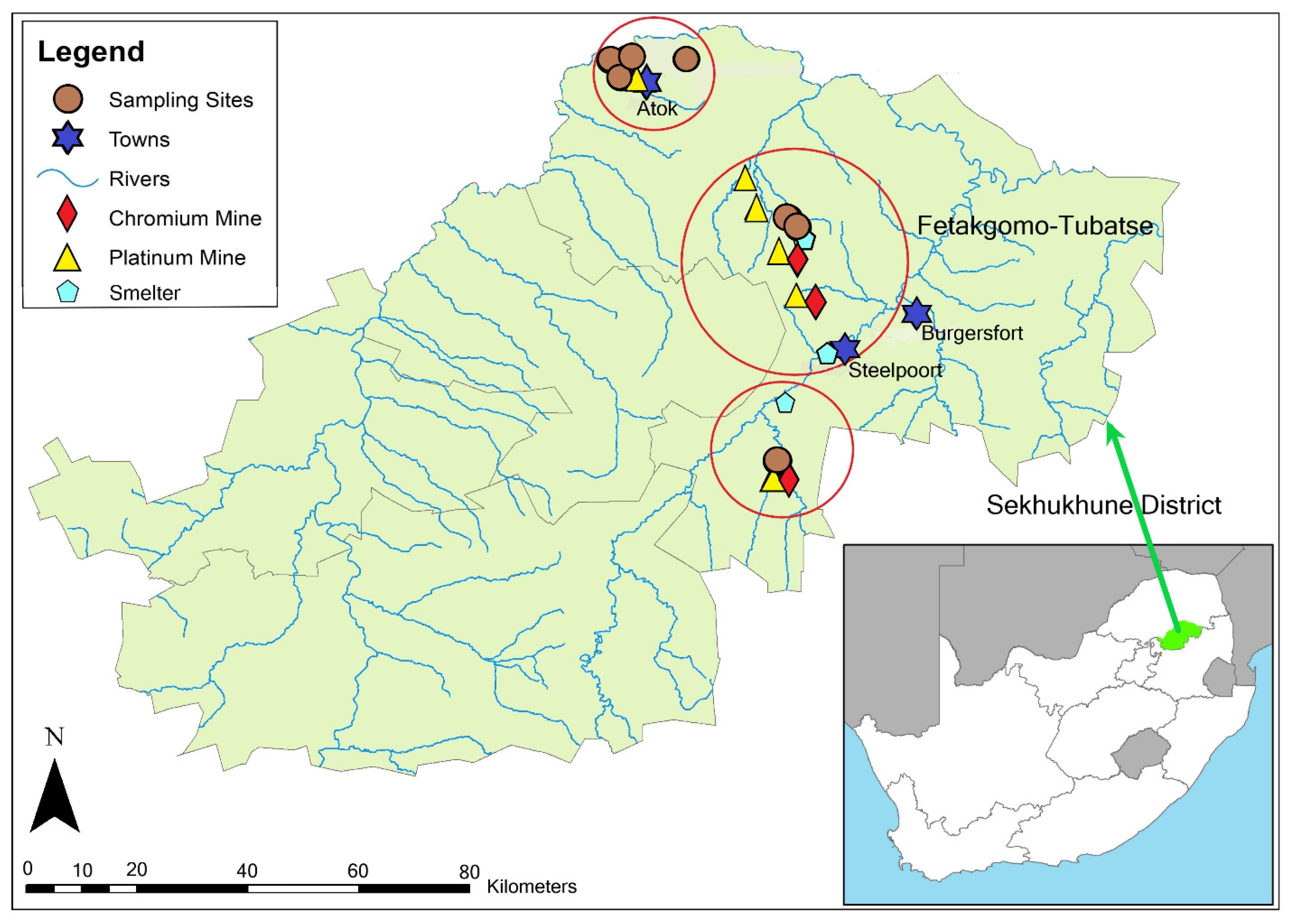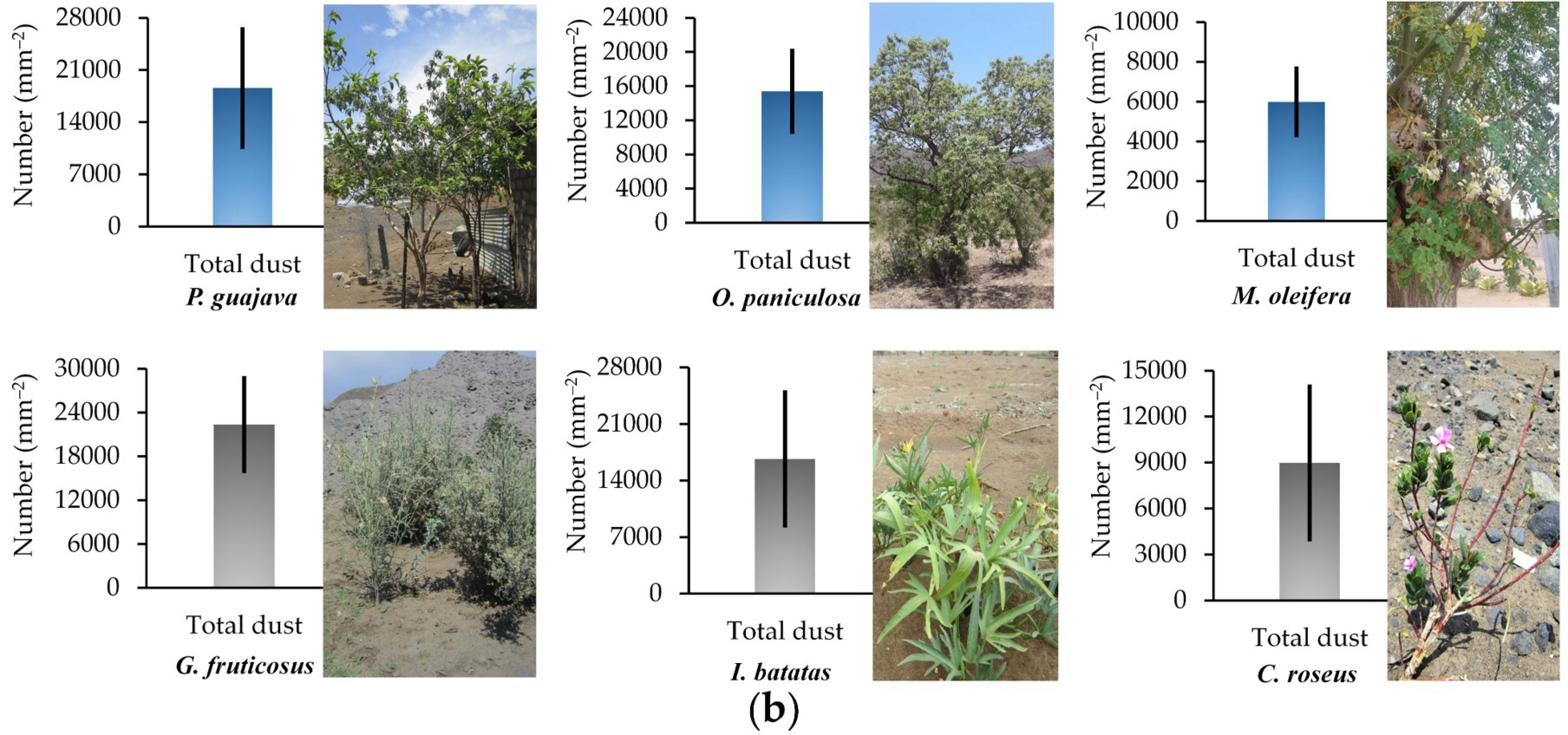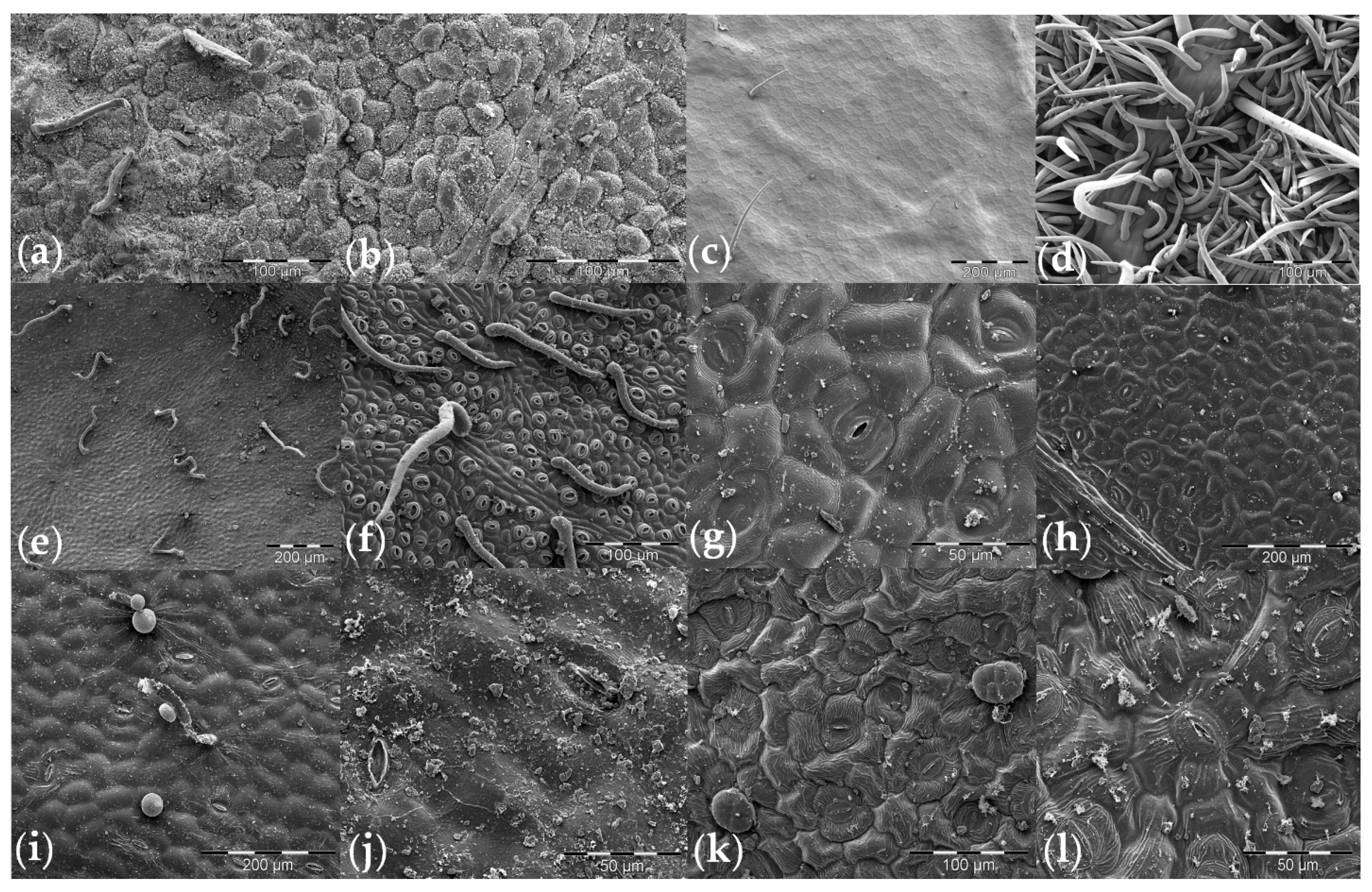Identifying Common Trees and Herbaceous Plants to Mitigate Particulate Matter Pollution in a Semi-Arid Mining Region of South Africa
Abstract
1. Introduction
2. Materials and Methods
2.1. Urban Conditions
2.2. Sampling and SEM Analysis of Leaves
3. Results and Discussion
3.1. Dust Accumulation Capacity of Plants
3.2. Accumulation of PM Size Fractions by Plants
3.3. Leaf Micromorphology Favoring Dust Accumulation
4. Conclusions
Author Contributions
Funding
Institutional Review Board Statement
Informed Consent Statement
Data Availability Statement
Acknowledgments
Conflicts of Interest
References
- Sæbø, A.; Popek, R.; Nawrot, B.; Hanslin, H.M.; Gawronska, H.; Gawronski, S.W. Plant species differences in particulate matter accumulation on leaf surfaces. Sci. Total Environ. 2012, 427–428, 347–354. [Google Scholar] [CrossRef] [PubMed]
- Entwistle, J.A.; Hursthouse, A.S.; Marinho Reis, P.A.; Stewart, A.G. Metalliferous mine dust: Human health impacts and the potential determinants of disease in mining communities. Curr. Pollut. Rep. 2019, 5, 67–83. [Google Scholar] [CrossRef]
- Csavina, J.; Field, J.; Taylor, M.P.; Gao, S.; Landázuri, A.; Betterton, E.A.; Sáez, A.E. A review on the importance of metals and metalloids in atmospheric dust and aerosol from mining operations. Sci. Total Environ. 2012, 433, 58–73. [Google Scholar] [CrossRef] [PubMed]
- Corriveau, M.C.; Jamieson, H.E.; Parsons, M.B.; Campbell, J.L.; Lanzirotti, A. Direct characterization of airborne particles associated with arsenic-rich mine tailings: Particle size, mineralogy and texture. Appl. Geochem. 2011, 26, 1639–1648. [Google Scholar] [CrossRef]
- Nocoń, K.; Rogula-Kozłowska, W.; Widziewicz, K. Research on chromium and arsenic speciation in atmospheric particulate matter: Short review. E3S Web Conf. 2018, 28, 01026. [Google Scholar] [CrossRef]
- Tshehla, C.; Djolov, G. Source profiling, source apportionment and cluster transport analysis to identify the sources of PM and the origin of air masses to an industrialised rural area in Limpopo. Clean Air J. 2018, 28, 54–66. [Google Scholar] [CrossRef]
- González-Castanedo, Y.; Moreno, T.; Fernández-Camacho, R.; Sánchez de la Campa, A.M.; Alastuey, A.; Querol, X.; de la Rosa, J. Size distribution and chemical composition of particulate matter stack emissions in and around a copper smelter. Atmos. Environ. 2014, 98, 271–282. [Google Scholar] [CrossRef]
- Cao, S.; Chen, X.; Zhang, L.; Xing, X.; Wen, D.; Wang, B.; Qin, N.; Wei, F.; Duan, X. Quantificational exposure, sources and health risks posed by heavy metals in indoor and outdoor household dust in a typical smelting area in China. Indoor Air 2020, 30, 872–884. [Google Scholar] [CrossRef]
- McAuliffe, J.; McFadden, L.; Hoffman, M. Role of aeolian dust in shaping landscapes and soils of arid and semi-arid South Africa. Geosciences 2018, 8, 171. [Google Scholar] [CrossRef]
- Javanmard, Z.; Kouchaksaraei, T.M.; Bahrami, H.; Hosseini, S.M.; Modarres, S.; Seyed, A.M.; Struve, D. Dust collection potential and air pollution tolerance indices in some young plant species in arid regions of Iran. iForest 2019, 12, 558–564. [Google Scholar] [CrossRef]
- González-Chávez, M.C.A.; Santiago-Martínez, M.E.; Corona-Sánchez, J.E.; Ruiz-Olivares, A.; Carrillo-González, R. Wild plants canopies may adsorb dust particles eroded from mine tailings, decreasing potentially toxic elements dispersion. Int. J. Environ. Sci. Technol. 2022, 1–12. [Google Scholar] [CrossRef]
- Alekseenko, A.V.; Drebenstedt, C.; Bech, J. Assessment and abatement of the eco-risk caused by mine spoils in the dry subtropical climate. Environ. Geochem. Health 2022, 44, 1581–1603. [Google Scholar] [CrossRef] [PubMed]
- Weber, F.; Kowarik, I.; Säumel, I. Herbaceous plants as filters: Immobilization of particulates along urban street corridors. Environ. Pollut. 2014, 186, 234–240. [Google Scholar] [CrossRef] [PubMed]
- Chen, L.; Liu, C.; Zhang, L.; Zou, R.; Zhang, Z. Variation in tree species ability to capture and retain airborne fine particulate matter (PM2.5). Sci. Rep. 2017, 7, 3206. [Google Scholar] [CrossRef]
- Singh, S.; Pandey, B.; Roy, L.B.; Shekhar, S.; Singh, R.K. Tree responses to foliar dust deposition and gradient of air pollution around opencast coal mines of Jharia coalfield, India: Gas exchange, antioxidative potential and tolerance level. Environ. Sci. Pollut. Res. 2021, 28, 8637–8651. [Google Scholar] [CrossRef]
- Chaurasia, M.; Patel, K.; Tripathi, I.; Rao, K.S. Impact of dust accumulation on the physiological functioning of selected herbaceous plants of Delhi, India. Environ. Sci. Pollut. Res. Int. 2022, 29, 80739–80754. [Google Scholar] [CrossRef]
- Schneider, L.; Allen, K.; Walker, M.; Morgan, C.; Haberle, S. Using tree rings to track atmospheric mercury pollution in Australia: The legacy of mining in Tasmania. Environ. Sci. Technol. 2019, 53, 5697–5706. [Google Scholar] [CrossRef]
- Przybysz, A.; Popek, R.; Stankiewicz-Kosyl, M.; Zhu, C.Y.; Małecka-Przybysz, M.; Maulidyawati, T.; Mikowska, K.; Deluga, D.; Griżuk, K.; Sokalski-Wieczorek, J.; et al. Where trees cannot grow—Particulate matter accumulation by urban meadows. Sci. Total Environ. 2021, 785, 147310. [Google Scholar] [CrossRef]
- Popek, R.; Beata, F.-P.; Chyliński, F.; Pawełkowicz, M.; Bobrowicz, J.; Chrzanowska, D.; Piechota, N.; Przybysz, A. Not only trees matter—Traffic-related PM accumulation by vegetation of urban forests. Sustainability 2022, 14, 2973. [Google Scholar] [CrossRef]
- Tshehla, C.; Wright, C.Y. Spatial variability of PM, PMand PM chemical components in an industrialised rural area within a mountainous terrain. S. Afr. J. Sci. 2019, 115, 1–10. [Google Scholar] [CrossRef]
- Adhikari, S.; Marcelo-Silva, J.; Beukes, J.P.; van Zyl, P.G.; Coetsee, Y.; Boneschans, R.B.; Siebert, S.J. Contamination of useful plant leaves with chromium and other potentially toxic elements and associated health risks in a polluted mining-smelting region of South Africa. Env. Adv. 2022, 9, 100301. [Google Scholar] [CrossRef]
- Nzuza, P.; Ramoelo, A.; Odindi, J.; Kahinda, J.M.; Madonsela, S. Predicting land degradation using Sentinel-2 and environmental variables in the Lepellane catchment of the Greater Sekhukhune District, South Africa. Phys. Chem. Earth Parts A/B/C 2021, 124, 102931. [Google Scholar] [CrossRef]
- Quinn, C.H.; Ziervogel, G.; Taylor, A.; Takama, T.; Thomalla, F. Coping with multiple stresses in rural South Africa. Ecol. Soc. 2011, 16, 2. [Google Scholar] [CrossRef]
- Adhikari, S.; Marcelo-Silva, J.; Rajakaruna, N.; Siebert, S.J. Influence of land use and topography on distribution and bioaccumulation of potentially toxic metals in soil and plant leaves: A case study from Sekhukhuneland, South Africa. Sci. Total Environ. 2022, 806, 150659. [Google Scholar] [CrossRef] [PubMed]
- Adhikari, S.; Jordaan, A.; Beukes, J.P.; Siebert, S.J. Anthropogenic sources dominate foliar chromium dust deposition in a mining-based urban region of South Africa. Int. J. Environ. Res. Public Health 2022, 19, 2072. [Google Scholar] [CrossRef] [PubMed]
- Adhikari, S.; Siebert, S.J.; Jordaan, A. Evidence of chromium dust pollution on the leaves of food and medicinal plants from mining areas of Sekhukhuneland, South Africa. S. Afr. J. Bot. 2021, 143, 226–237. [Google Scholar] [CrossRef]
- Watanabe, Y. Canopy, leaf surface structure and tree phenology: Arboreal factors influencing aerosol deposition in forests. J. Agric. Meteorol. 2015, 71, 167–173. [Google Scholar] [CrossRef]
- Flett, F.; McLeod, C.L.; McCarty, J.L.; Shaulis, B.J.; Fain, J.J.; Krekeler, M.P.S. Monitoring uranium mine pollution on native American lands: Insights from tree bark particulate matter on the Spokane Reservation, Washington, USA. Environ. Res. 2022, 194, 110619. [Google Scholar] [CrossRef]
- Patel, K.; Chaurasia, M.; Rao, K.S. Urban dust pollution tolerance indices of selected plant species for development of urban greenery in Delhi. Environ. Monit. Assess. 2022, 195, 16. [Google Scholar] [CrossRef]
- Bharti, S.K.; Trivedi, A.; Kumar, N. Air pollution tolerance index of plants growing near an industrial site. Urban Clim. 2018, 24, 820–829. [Google Scholar] [CrossRef]
- Kushwaha, U.; Shrivastava, R.; Mishra, A. Dust pollution effects on the leaves anatomy of Catharanthus roseus and Nerium oleander growing along the road side of Rewa City (M.P.). Int. J. Eng. Sci. 2018, 7, 1–7. [Google Scholar] [CrossRef]
- Lee, J.K.; Do, Y.K.; Sang, H.P.; Su, Y.W.; Hualin, N.; Sun, H.K. Particulate matter (PM) adsorption and leaf characteristics of ornamental sweet potato (Ipomoea batatas L.) cultivars and two common indoor plants (Hedera helix L. and Epipremnum aureum Lindl. & Andre). Horticulturae 2022, 8, 26. [Google Scholar] [CrossRef]
- Prajapati, S.K.; Tripathi, B.D. Seasonal variation of leaf dust accumulation and pigment content in plant species exposed to urban particulates pollution. J. Environ. Qual. 2008, 37, 865. [Google Scholar] [CrossRef]
- Rai, P.K.; Panda, L.L.S. Dust capturing potential and air pollution tolerance index (APTI) of some road side tree vegetation in Aizawl, Mizoram, India: An Indo-Burma hot spot region. Air Qual. Atmos. Health 2013, 7, 93–101. [Google Scholar] [CrossRef]
- Sultana, Z.; Rehman, M.Y.A.; Khan, H.K.; Malik, R.N. Health risk assessment associated with heavy metals through fractioned dust from coal and chromite mines in Pakistan. Environ. Geochem. Health 2022, 1–17. [Google Scholar] [CrossRef]
- Berryman, E.J.; Paktunc, D.; Kingston, D.; Beukes, J.P. Composition and Cr- and Fe-speciation of dust generated during ferrochrome production in a DC arc furnace. Clean. Eng. Technol. 2022, 6, 100386. [Google Scholar] [CrossRef]
- Wu, Y.; Ma, W.; Liu, J.; Zhu, L.; Cong, L.; Zhai, J.; Wang, Y.; Zhang, Z. Sabina chinensis and Liriodendron chinense improve air quality in Beijing, China. PLoS ONE 2018, 13, e0189640. [Google Scholar] [CrossRef]
- Tian, S.; Liang, T.; Li, K. Fine road dust contamination in a mining area presents a likely air pollution hotspot and threat to human health. Environ. Int. 2019, 128, 201–209. [Google Scholar] [CrossRef]
- Tallis, M.; Taylor, G.; Sinnett, D.; Freer-Smith, P. Estimating the removal of atmospheric particulate pollution by the urban tree canopy of London, under current and future environments. Landsc. Urban Plan. 2011, 103, 129–138. [Google Scholar] [CrossRef]
- Mo, L.; Ma, Z.; Xu, Y.; Sun, F.; Lun, X.; Liu, X.; Chen, J.; Yu, X. Assessing the capacity of plant species to accumulate particulate matter in Beijing, China. PLoS ONE 2015, 10, e0140664. [Google Scholar] [CrossRef]
- Leonard, R.J.; McArthur, C.; Hochuli, D.F. Particulate matter deposition on roadside plants and the importance of leaf trait combinations. Urban For. Urban Green. 2016, 20, 249–253. [Google Scholar] [CrossRef]
- Panes, V.A.; Zamora, P.M. Leaf epidermal features of four Philippine plants as indicators of cement dust pollution. Philipp. J. Sci. 1991, 120, 249–267. [Google Scholar]
- Chiam, Z.; Song, X.P.; Lai, H.R.; Tan, H.T.W. Particulate matter mitigation via plants: Understanding complex relationships with leaf traits. Sci. Total Environ. 2019, 688, 398–408. [Google Scholar] [CrossRef] [PubMed]
- Ruwanza, S.; Thondhlana, G.; Falayi, M. Research progress and conceptual insights on drought impacts and responses among smallholder farmers in South Africa: A review. Land 2022, 11, 159. [Google Scholar] [CrossRef]





| Source | PM Sizes | Plant Species |
|---|---|---|
| Mines | Ultrafine (<0.1 µm, tailings); fine (high temperature processes); coarse and large PM (excavation and grinding) | All six species |
| Smelters | Ultrafine, fine and coarse PM | C. roseus, G. fruticosus, O. paniculosa, P. guajava, |
| Transportation | Fine (tailings) and coarse PM (mines) | C. roseus, G. fruticosus, I. batatas, M. oleifera |
Disclaimer/Publisher’s Note: The statements, opinions and data contained in all publications are solely those of the individual author(s) and contributor(s) and not of MDPI and/or the editor(s). MDPI and/or the editor(s) disclaim responsibility for any injury to people or property resulting from any ideas, methods, instructions or products referred to in the content. |
© 2022 by the authors. Licensee MDPI, Basel, Switzerland. This article is an open access article distributed under the terms and conditions of the Creative Commons Attribution (CC BY) license (https://creativecommons.org/licenses/by/4.0/).
Share and Cite
Adhikari, S.; Struwig, M.; Siebert, S.J. Identifying Common Trees and Herbaceous Plants to Mitigate Particulate Matter Pollution in a Semi-Arid Mining Region of South Africa. Climate 2023, 11, 9. https://doi.org/10.3390/cli11010009
Adhikari S, Struwig M, Siebert SJ. Identifying Common Trees and Herbaceous Plants to Mitigate Particulate Matter Pollution in a Semi-Arid Mining Region of South Africa. Climate. 2023; 11(1):9. https://doi.org/10.3390/cli11010009
Chicago/Turabian StyleAdhikari, Sutapa, Madeleen Struwig, and Stefan John Siebert. 2023. "Identifying Common Trees and Herbaceous Plants to Mitigate Particulate Matter Pollution in a Semi-Arid Mining Region of South Africa" Climate 11, no. 1: 9. https://doi.org/10.3390/cli11010009
APA StyleAdhikari, S., Struwig, M., & Siebert, S. J. (2023). Identifying Common Trees and Herbaceous Plants to Mitigate Particulate Matter Pollution in a Semi-Arid Mining Region of South Africa. Climate, 11(1), 9. https://doi.org/10.3390/cli11010009






